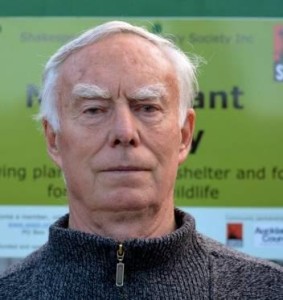Alan Parker steps down
At our recent AGM Allan Parker stood down as Chairman, having overseen the Society and the Sanctuary since their inception 10 years ago. Along with Jean Bell (who died last year) he was also awarded a Community Volunteers Award 2013 by the Hibiscus and Bays Local Board of the Auckland Council.
Matt Maitland, Open Sanctuary Coordinator for Auckland Council, has worked closely with Allan and says of him: “Allan has been an exceptionally strong community leader. Auckland Council and SOSSI enjoy a strong relationship focused on the shared development of the open sanctuary and the return of native wildlife to this special place. As Chair, Allan has led SOSSI in this partnership through three distinct phases; from lobbying council, to fundraising and now into the operational stage with the return of missing species now within our grasp.”
 As an 11-year-old Allan started a bird watching club with his friends, the start of a life-long interest in nature. He grew up in rural England where he had freedom to roam on unspoiled estates, so it is no surprise that he is now living next to our beautiful regional park. His cue to action over the Sanctuary was the decision by the Rodney County Council to site the sewage plant for the whole Hibiscus Coast next to the park. While this caused local dismay it also led Allan to discover that the ARC was thinking of establishing an open sanctuary at Shakespear, so he and Jean Bell promptly made representations to the ARC to establish a community group in support of the idea.
As an 11-year-old Allan started a bird watching club with his friends, the start of a life-long interest in nature. He grew up in rural England where he had freedom to roam on unspoiled estates, so it is no surprise that he is now living next to our beautiful regional park. His cue to action over the Sanctuary was the decision by the Rodney County Council to site the sewage plant for the whole Hibiscus Coast next to the park. While this caused local dismay it also led Allan to discover that the ARC was thinking of establishing an open sanctuary at Shakespear, so he and Jean Bell promptly made representations to the ARC to establish a community group in support of the idea.
The signing of a Memorandum of Understanding with ARC gave SOSSI the authority and credibility to work with other interested parties and with ARC staff. It then took about two years for all the options for a fence to be explored before the current route was decided, with the active support of the Navy to include defence land within the sanctuary. SOSSI had to contribute $500,000 toward the fence, for which serious fund-raising began in 2008. The idea of a sanctuary excited the local community and enjoyed strong interest from media and so the “Purchase a Post” appeal worked very well, but most of the funding was raised by SOSSI through grants. At the same time SOSSI was promoting the idea locally and building volunteer support for all of the ongoing work such as fence-checking, trapping and raising plants.
But Allan feels that the most challenging part was yet to come – obtaining a resource consent for the aerial bait drop. Publication of the consent application drew opposition from far and wide. However SOSSI had previously shared the pest removal process publicly through its newsletters and numerous presentations, and without encountering significant local opposition. With hindsight, Allan thinks that was a crucial contribution to the consent process.
Now, 10 years on, Allan feels that everything he hoped for has come to pass. We have a fence, enthusiastic volunteers, good community support and a good relationship with the Auckland Council – all the components of a working open sanctuary. Allan would now like to see the sanctuary idea spreading beyond the fence, with local residents encouraging birds in their own gardens. To that end he wants now to change his own role and work with schools and others on education about the sanctuary. And maybe have a holiday.
